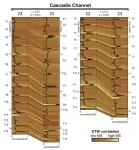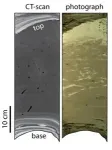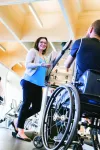(Press-News.org) The Cascadia subduction zone in the Pacific Northwest has a history of producing powerful and destructive earthquakes that have sunk forests and spawned tsunamis that reached all the way to the shores of Japan.
The most recent great earthquake was in 1700. But it probably won’t be the last. And the area that stands to be affected is now bustling metropolises that are home to millions of people.
Figuring out the frequency of earthquakes – and when the next “big one” will happen – is an active scientific question that involves looking for signs of past earthquakes in the geologic record in the form of shaken up rocks, sediment and landscapes.
However, a study by scientists at The University of Texas at Austin and collaborators is calling into question the reliability of an earthquake record that covers thousands of years – a type of geologic deposit called a turbidite that’s found in the strata of the seafloor.
The researchers analyzed a selection of turbidite layers from the Cascadia subduction zone dating back about 12,000 years ago with an algorithm that assessed how well turbidite layers correlated with one another.
They found that, in most cases, the correlation between the turbidite samples was no better than random. Since turbidites can be caused by a range of phenomena, and not just earthquakes, the results suggest that the turbidite record’s connection to past earthquakes is more uncertain than previously thought.
"We would like everyone citing the intervals of Cascadia subduction earthquakes to understand that these timelines are being questioned by this study," said Joan Gomberg, a research geophysicist at the U.S. Geological Survey and study co-author. "It’s important to conduct further research to refine these intervals. What we do know is that Cascadia was seismically active in the past and will be in the future, so ultimately, people need to be prepared."
The results don’t necessarily change the estimated earthquake frequency in Cascadia, which is about every 500 years, said the researchers. The current frequency estimate is based on a range of data and interpretations, not just the turbidites analyzed in this study. However, the results do highlight the need for more research on turbidite layers, specifically, and how they relate to each other and large earthquakes.
Co-author Jacob Covault, a research professor at the UT Jackson School of Geosciences, said the algorithm offers a quantitative tool that that provides a replicable method for interpreting ancient earthquake record, which are usually based on more qualitative descriptions of the geology and their potential associations.
“This tool provides a repeatable result, so everybody can see the same thing,” said Covault, the co-principal investigator of the Quantitative Clastics lab at the Jackson School’s Bureau of Economic Geology. “You can potentially argue with that result, but at least you have a baseline, an approach that is reproducible.”
The results were published in the journal GSA Bulletin. The study includes researchers from the USGS, Stanford University and the Alaska Division of Geological & Geophysical Surveys.
Turbidites are the remnants of underwater landslides. They’re made of sediments that settled back down to the seafloor after being flung into the water by the turbulent motion of sediment rushing across the ocean floor. The sediment in these layers have a distinctive gradation, with coarser grains at the bottom and finer ones at the top.
But there’s more than one way to make a turbidite layer. Earthquakes can cause landslides when they shake up the seafloor. But so can storms, floods and a range of other natural phenomena, albeit on a geographic smaller scale.
Currently, connecting turbidites to past earthquakes usually involves finding them in geologic cores taken from the seafloor. If a turbidite shows up in roughly the same spot in multiple samples across a relatively large area, it’s counted as a remnant of a past earthquake, according to the researchers.
Although carbon dating samples can help narrow down timing, there’s still a lot of uncertainty in interpreting if samples that appear at about the same time and place are connected by the same event.
Getting a better handle on how different turbidite samples relate to one another inspired the researchers to apply a more quantitative method – an algorithm called “dynamic time warping” – to the turbidite data. The algorithmic method dates back to the 1970s and has a wide range of applications, from voice recognition to smoothing out graphics in dynamic VR environments.
This is the first time it has been applied to analyzing turbidites, said co-author Zoltán Sylvester, a research professor at the Jackson School and co-principal investigator of the Quantitative Clastics Lab, who led the adaption of the algorithm for analyzing turbidites.
“This algorithm has been a key component of a lot of the projects I have worked on,” said Sylvester. “But it’s still very much underused in the geosciences.”
The algorithm detects similarity between two samples that may vary over time, and determines how closely the data between them matches.
For voice recognition software, that means recognizing key words even though they might be spoken at different speeds or pitches. For the turbidites, it involves recognizing shared magnetic properties between different turbidite samples that may look different from location to location despite originating from the same event.
“Correlating turbidites is no simple task,” said co-author Nora Nieminski, the coastal hazards program manager for the Alaska Division of Geological & Geophysical Surveys. “Turbidites commonly demonstrate significant lateral variability that reflect their variable flow dynamics. Therefore, it is not expected for turbidites to preserve the same depositional character over great distances, or even small distances in many cases, particularly along active margins like Cascadia or across various depositional environments.”
The researchers also subjected the correlations produced by the algorithm to another level of scrutiny. They compared the results to correlation data calculated using synthetic data made by comparing 10,000 pairs of random turbidite layers. This synthetic comparison served as a control against coincidental matches in the actual samples.
The researchers applied their technique to magnetic susceptibility logs for turbidite layers in nine geologic cores that were collected during a scientific cruise in 1999. They found that in most cases, the connection between turbidite layers that had been previously correlated was no better than random. The only exception to this trend was for turbidite layers that were relatively close together – no more than about 15 miles apart.
The researchers emphasize that the algorithm is just one way of analyzing turbidities, and that the inclusion of other data could change the degree of correlation between the cores one way or another. But according to these results, the presence of turbidities at the same time and general area in the geologic record is not enough to definitively connect them to one another.
And although algorithms and machine learning approaches can help with that task, it’s up to geoscientists to interpret the results and see where the research leads.
“We are here for answering questions not just applying the tool,” Sylvester said. “But at the same time, if you are doing this kind of work, then it forces you to think very carefully.”
END
Algorithm raises new questions about Cascadia earthquake record
2024-08-27
ELSE PRESS RELEASES FROM THIS DATE:
Defining chronic pain for high-performance athletes with disabilities
2024-08-27
With the Paris 2024 Paralympic Games just around the corner, the extensive training and the sacrifices athletes make to compete at the games take centre stage.
For Paralympians and high-performance athletes with spinal cord injuries (SCI), assessing chronic pain plays a key role in their training and readiness to compete. However, the source of chronic pain is often misattributed to acute trauma or overuse injuries. While the International Olympic Committee acknowledges pain management data among Paralympians and athletes with disabilities is limited, few studies have been launched investigating this dilemma.
Now, new research from UBC Okanagan highlights the need for more comprehensive ...
Illinois researchers develop near-infrared spectroscopy models to analyze corn kernels, biomass
2024-08-27
URBANA, Ill. – In the agricultural and food industry, determining the chemical composition of raw materials is important for production efficiency, application, and price. Traditional laboratory testing is time-consuming, complicated, and expensive. New research from the University of Illinois Urbana-Champaign demonstrates that near-infrared (NIR) spectroscopy and machine learning can provide quick, accurate, and cost-effective product analysis.
In two studies, the researchers explore the use of NIR spectroscopy for analyzing characteristics of corn kernels and sorghum biomass.
“NIR spectroscopy has many advantages over traditional methods. ...
It’s the most common STI you’ve never heard of. Will this newly developed drug provide the cure?
2024-08-27
Researchers at Tulane University are leading a groundbreaking study to seek a more effective treatment for trichomoniasis, an infection that, despite being the most common curable sexually transmitted infection (STI) worldwide, continues to fly under the radar.
The five-year, multi-center study is funded by a $9.2 million National Institutes of Health grant and will compare the effectiveness of a recently approved medication, secnidazole, against the current standard treatment, metronidazole, using ...
Texas A&M researchers find that aoudad, bighorn sheep share respiratory pathogens
2024-08-27
By Courtney Price, Texas A&M College of Veterinary Medicine and Biomedical Sciences
A team of researchers at the Texas A&M College of Veterinary Medicine and Biomedical Sciences (VMBS) has discovered that aoudad — an animal in the sheep and goat family — can catch and spread many of the same respiratory pathogens that can impact desert bighorn sheep, a native species in Texas that often shares its habitat with aoudad.
The new research, recently published in the journal PLOS ONE, will help wildlife conservationists better understand the complex relationship between ...
CRF announces TCT 2024 late-breaking clinical trials and science
2024-08-27
NEW YORK – August 27, 2024 – The Cardiovascular Research Foundation® (CRF®) is pleased to announce the late-breaking clinical trials and science to be featured at TCT® 2024. As the annual scientific symposium of CRF® and the world’s premier educational meeting specializing in interventional cardiovascular medicine, TCT® 2024 will be held October 27-30 in Washington, D.C. at the Walter E. Washington Convention Center.
For over three decades, TCT® has been at the forefront of innovation, education, and collaboration in interventional ...
Not sure how to stand out as a leader on Zoom calls? It starts with how you communicate, new study shows
2024-08-27
BINGHAMTON, N.Y. -- More companies are embracing remote work, and with that comes a need for more frequent communication. Teamwork through a screen isn’t always the same as having a group in the same room, so how are companies cultivating leaders in these virtual settings?
New research involving a collaboration between Binghamton University, State University of New York schools and research centers shows how, in virtual teams where nonverbal cues are limited, a person’s engagement and influence in conversations can significantly shape whether they’re perceived as a leader.
But taking charge of the conversation isn’t enough, the study found; for leadership ...
Prenatal smoking risks academic achievement of unborn babies
2024-08-27
Smoking harms almost every part of your body. But if you smoke when pregnant, the toxic chemicals in tobacco will also harm your unborn baby, with new research showing that it could lead to reduced academic outcomes at school.
In a systematic review of 19 studies and 1.25 million participants, researchers at the University of South Australia along with a team at Curtin University, SAHMRI, Harvard University and others* found that 79% of studies reported reduced academic achievement in children exposed to maternal prenatal smoking.
An additional meta-analysis of eight primary studies with 723,877 participants ...
The importance of brand strength when designing group and individual sales incentives in brand-managed retail sales settings
2024-08-27
Researchers from Wake Forest University and University of California-Riverside published a new Journal of Marketing article that examines the dynamic BMR retail context and investigates the sales incentives there.
The study, forthcoming in the Journal of Marketing, is titled “Group or Individual Sales Incentives? What is Best for Brand-Managed Retail Sales Operations?” and is authored by Wenshu Zhang, Jia Li, and Subramanian Balachander.
Should a brand adopt group or individual sales incentives for its retail sales force? Could differences in brand strength or brand equity affect how brands incentivize their sales ...
Discovery gives answers to parents of children with rare disease
2024-08-27
Shortly after Kelly Cervantes’ daughter Adelaide was born, she started having terrible seizures. Doctors were unable to give her a solution, or even a cause.
“We never had an overarching diagnosis for her, which was extraordinarily frustrating and isolating,” she says. “If we did, we could join groups or talk to people who had various symptoms in common. We also had no idea what her prognosis looked like, or if we could have other children.”
Over time her condition worsened and sadly she died five days before her fourth birthday.
“She ...
UT Health San Antonio School of Dentistry names director of Center for Pain Therapeutics and Addiction Research
2024-08-27
SAN ANTONIO, Aug. 27, 2024 – Kenneth M. Hargreaves, DDS, PhD, professor of endodontics at the School of Dentistry of The University of Texas Health Science Center at San Antonio (UT Health San Antonio), has been named inaugural director of the school’s Center for Pain Therapeutics and Addiction Research.
Hargreaves, who chaired the Department of Endodontics at the school for 26 years, is a world-renowned expert in pain research and has served as principal or co-principal investigator on numerous National Institutes of Health, Department of Defense and foundation-funded projects totaling more than $139 million.
Just recently, his research proposal, ...







